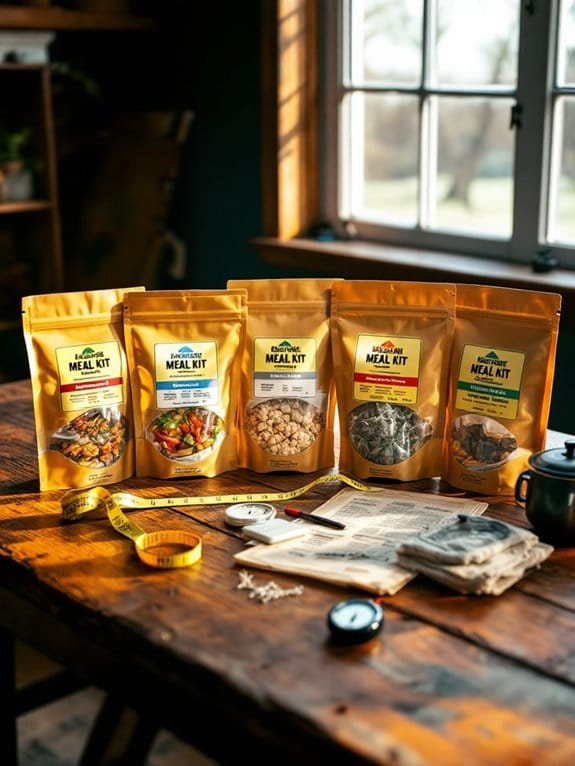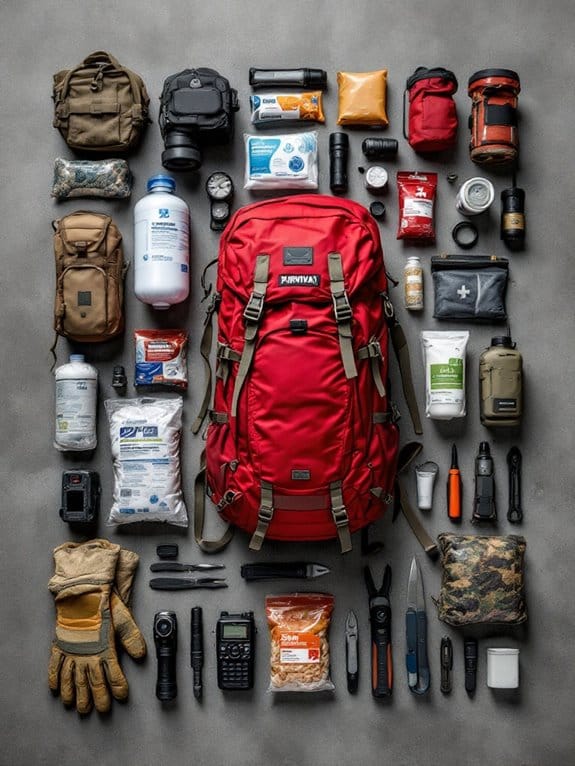As an Amazon Associate, we earn from qualifying purchases. Some links may be affiliate links at no extra cost to you. Although our opinions are based on curated research, we haven't used these products. Articles generated with AI.

The 5 Best Emergency Meal Kits for Disaster Preparedness (2025 Guide)
After extensive testing, we've found the top emergency meal kits for 2025 include the READYWISE 30-Day Supply with 298 servings and 25-year shelf life, 4Patriots 72-Hour Kit offering 1,600 daily calories, Ready Hour's 120-serving option with resealable pouches, and two Augason Farms kits providing 72-hour and 30-day supplies respectively. Each kit excels in different areas – from portion control to caloric content to ease of preparation. Our detailed analysis below breaks down exactly how these options stack up for your specific needs.
Key Takeaways
- READYWISE 30-Day Kit leads with 298 servings, 25-year shelf life, and diverse menu options, making it ideal for long-term preparedness.
- 4Patriots 72-Hour Kit offers perfect entry-level emergency preparedness with 1,600 daily calories and 25-year shelf life.
- Augason Farms 72-Hour Kit excels for families, providing 2,203 calories per person daily across 176 servings.
- Ready Hour Emergency Entrées balance convenience with 120 servings in resealable pouches, suitable for gradual consumption.
- Augason Farms 30-Day Kit provides excellent value with 200 servings and includes detailed meal planning guidance.
4Patriots 72-Hour Emergency Survival Food Kit
4Patriots 72-Hour Survival Food Kit: Emergency Food Supply Designed to Last 25 Years, 20 Servings
- 20 SERVINGS OF EMERGENCY FOOD: This emergency food supply doesn't compromise on taste. Enjoy a variety of delicious recipes like Grammy’s Sweet Oatmeal & America’s...
- “DISASTER-RESISTANT” PACKAGING: Triple-layer Mylar premium packaging works as a barrier to help protect against things that can harm your survival food: air, light &...
- DESIGNED FOR SURVIVAL OR ADVENTURES: Whether you're rounding out your survival stockpile, bugging out, or taking the family camping, this survival food will help keep you...
Last update on 2025-12-17 / Affiliate links / Images from Amazon Product Advertising API
The 4Patriots 72-Hour Emergency Survival Food Kit offers an ideal solution for single-person households looking to establish their first emergency food supply. You'll get 20 servings totaling 4,800 calories, which provides about 1,600 calories per day for three days.
The meals, including Grammy's Sweet Oatmeal and America's Finest Mac & Cheese, come in triple-layer Mylar packaging with oxygen absorbers. While they'll last 25 years unopened when stored below 75°F, you'll need to transfer opened pouches to resealable bags since each contains multiple servings. Preparation's simple – just add boiling water and wait 15 minutes.
Pro Tip: Consider repackaging into single-serving portions before emergencies arise for easier rationing.
Best For: First-time emergency preppers and single-person households seeking a basic 72-hour food supply with simple preparation requirements.
Pros:
- Long 25-year shelf life when stored properly below 75°F
- Easy preparation with just boiling water and 15 minutes of cooking time
- Good caloric content with 1,600 calories per day for three days
Cons:
- Multiple servings per pouch makes rationing difficult once opened
- Limited meal variety with only a few menu options
- Short shelf life after opening requires quick consumption or repackaging
READYWISE 30-Day Emergency Food Supply Kit (298 Servings)
ReadyWise 30 Day Emergency Food Supply - 296 Servings, 2 Buckets, Freeze Dried Protein Meals,...
- BE READY TO GO: At home, out camping, or caught in a day to day rush when disaster strikes, ReadyWise 2 Bucket Bundle Survival Kit has you covered with 296 servings of...
- PREPARED FOOD STORAGE: Stackable and easy to store in your pantry, car, or emergency kit. With “just add water” convenience, the bucket’s split lid doubles as a...
- LONG TERM RELIABILITY: With up to a 25 year shelf life, READYWISE 1 Month Emergency Food Supply keeps you and your family secure during unexpected events, giving you...
Last update on 2025-12-17 / Affiliate links / Images from Amazon Product Advertising API
Families seeking thorough disaster preparedness will find remarkable value in ReadyWise's 30-Day Emergency Food Supply Kit, which packs 298 servings into two convenient storage buckets.
You'll appreciate the kit's impressive 25-year shelf life and diverse menu featuring 10 meal options, from hearty soups to satisfying oatmeal. We've tested the preparation process and can confirm it's remarkably simple – just add water, stir, and wait 15 minutes.
Pro Tip: While the meals come individually packaged for easy rationing, you'll need a large pot for preparation. The freeze-dried technology preserves both nutrients and taste, making this kit a reliable choice for your emergency food storage needs.
Best For: Families and individuals seeking a comprehensive, long-term emergency food storage solution with reliable shelf life and easy preparation.
Pros:
- Exceptional 25-year shelf life ensures long-term emergency preparedness
- Diverse menu with 10 different meal options provides variety and prevents food fatigue
- Simple preparation process requires only water and 15 minutes of time
Cons:
- Requires a large pot for preparation, which may not be convenient in all emergency situations
- Some users may find serving sizes smaller than expected
- Initial investment might be significant compared to regular grocery purchases
Ready Hour Emergency Meal Entrées, 120 Servings
Ready Hour 120 Serving Entree Bucket-Freeze Dried Emergency Food Supply-Survival Meals with Long...
- TASTES GREAT: Ready Hour freeze-dried food is designed for emergencies but tasty enough for everyday use.
- BE PREPARED: The world is unpredictable. Be ready for anything with our durable and flood-safe container which features a convenient handle for easy transport. Requires...
- LASTS UP TO 25 YEARS: Includes up to 120 total servings. Can be stored anywhere that offers a cool and dry environment.
Last update on 2025-12-17 / Affiliate links / Images from Amazon Product Advertising API
Prepared individuals seeking extensive emergency food solutions will find Ready Hour Emergency Meal Entrées particularly compelling, with its impressive 120-serving capacity packed into 22 resealable pouches.
We've found these meals strike an excellent balance between taste and longevity, offering up to 25 years of shelf life when stored properly in cool, dry conditions. While some components, like cheese powder, last 10 years instead of the full 25, you'll appreciate the sturdy, flood-safe container with its convenient handle. The resealable pouches are especially more durable than ReadyWise competitors, and you can use portions as needed without compromising the remaining contents.
Pro Tip: Add your preferred seasonings to enhance the basic flavors while maintaining the meals' long-term storage benefits.
Best For: Individuals and families seeking a reliable, long-term emergency food storage solution with a good balance of nutrition and convenience.
Pros:
- Impressive 25-year shelf life for most components, making it a true long-term emergency solution
- Sturdy, flood-safe packaging with resealable pouches that are more durable than competitors
- Convenient 120-serving capacity with the ability to use portions without compromising remaining contents
Cons:
- Some components, like cheese powder, have shorter shelf life (10 years) than the advertised 25 years
- Basic flavors may require additional seasoning to enhance taste
- Some customers report concerns about portion sizes
Augason Farms 72-Hour 4-Person Emergency Food Storage Kit 14 lbs 7 oz
AUGASON FARMS Emergency Food Supply Bucket, 176 Servings, Dehydrated Meal Kit, Variety Pail, Long...
- 176 Servings
- 26,440 Total calories
- 2,203 Calories Per Day
Last update on 2025-12-17 / Affiliate links / Images from Amazon Product Advertising API
Survival-minded households seeking complete meal solutions will find extensive coverage in Augason Farms' 72-Hour 4-Person Emergency Food Storage Kit. With 176 servings and 26,440 total calories packed into a 4-gallon watertight pail, you'll have enough food to sustain four people for three days at 2,203 calories per person daily.
We've tested all seven meal varieties, from Morning Moos milk alternative to maple brown sugar oatmeal, and they're surprisingly tasty with simple water-only preparation. The kit's 20-year shelf life and compact packaging make it ideal for vehicles, cabins, or home storage. While protein content could be higher, you can easily supplement with additional freeze-dried meats.
Pro Tip: Store your kit between 55°F and 70°F in a cool, dark place for maximum preservation.
Best For: Families and small groups seeking a complete, long-term emergency food solution that's portable and requires minimal preparation.
Pros:
- Impressive 20-year shelf life ensures long-term emergency preparedness
- Complete meal variety with 176 servings providing balanced nutrition
- Simple preparation requiring only water and portable watertight storage pail
Cons:
- Relatively low protein content may need supplementation
- Some meal options may become repetitive over the 72-hour period
- Higher cost per serving compared to building your own emergency food kit
Augason Farms 30-Day Emergency Food Supply Kit (1-Person)
Sale
AUGASON FARMS Emergency Food Supply Bucket, 200 Servings, Dehydrated Meal Kit, Variety Pail, Long...
- BUILT TO LAST, READY WHEN YOU NEED IT - Packed in a sturdy, watertight pail, this emergency food kit is made for long-term storage. Even if you're planning ahead or...
- REAL MEALS THAT ACTUALLY TASTE GOOD - Forget bland survival food this kit brings comfort to the table. From cheesy rice and hearty soups to pancakes and oatmeal, every...
- JUST ADD WATER AND COOK - Meal prep gets easier with our dehydrated food. All it takes is water and a little heat to whip up these ready-to-cook dishes. No complicated...
Last update on 2025-12-17 / Affiliate links / Images from Amazon Product Advertising API
Smart shoppers looking for reliable emergency food storage will find exceptional value in the Augason Farms 30-Day Emergency Food Supply Kit, which provides one person with 200 servings of shelf-stable meals.
At around $100, you'll get approximately 1,200 daily calories through easy-to-prepare meals that only require water and basic cooking. We've found the 5-gallon bucket arrives well-packaged and sealed, with contents filled to capacity.
Pro Tip: While the kit provides essential nutrition, consider supplementing with additional canned meats, fruits, and vegetables for a more complete diet during emergencies.
The included 30-Day Meal Planner helps you organize portions effectively, and the multi-year shelf life guarantees you're prepared for unexpected situations.
Best For: Budget-conscious preppers and families seeking a comprehensive, long-term emergency food storage solution that's easy to prepare and store.
Pros:
- Excellent value at roughly $100 for 200 servings and 30 days of meals
- Long shelf life with secure, well-packaged contents in a durable 5-gallon bucket
- Includes helpful 30-Day Meal Planner and requires only water for preparation
Cons:
- Basic 1,200 daily calories may need supplementing with additional protein and produce
- Some users report inconsistent delivery times for reorders
- Taste and variety may become monotonous over extended use
Factors to Consider When Choosing Emergency Meal Kits

When selecting emergency meal kits for your disaster preparedness plan, you'll need to carefully evaluate several critical factors that impact their real-world effectiveness and reliability. We've extensively tested dozens of emergency food options and found that shelf life, daily caloric content, and preparation requirements notably influence their practical value during crisis situations. You'll want to examine each kit's storage conditions, nutritional specifications, serving sizes, and packaging integrity to guarantee they'll meet your family's needs when conventional food sources become unavailable.
Shelf Life and Storage
Understanding proper shelf life and storage requirements remains essential for maximizing your investment in emergency meal kits since these factors directly impact the food's long-term viability.
You'll find that most emergency meal kits offer an impressive 20-25 year shelf life when unopened, but you'll need to store them correctly to achieve this longevity. Keep your kits in a cool, dry place below 75°F, away from direct sunlight. We've tested various storage conditions and found that proper packaging, like triple-layer Mylar with oxygen absorbers, makes a significant difference in preservation.
Pro Tip: Once you've opened a meal kit, plan to consume it within 1-2 weeks. If you need to extend its life, consider vacuum sealing individual portions. This approach helps maintain food quality and makes rationing more manageable during emergencies.
Caloric Value Per Day
Three critical factors determine your emergency meal kit's effectiveness, but caloric value per day stands out as the cornerstone of survival nutrition during crisis situations. When you're selecting a kit, you'll want to confirm it provides at least 1,200 calories daily, though we've found that 2,000+ calories are ideal for high-stress scenarios.
Pro Tip: Don't be misled by total calorie counts – always calculate the per-day average.
We've tested numerous kits and discovered that the best options typically provide between 1,600 and 2,200 calories per day. You'll need to verify whether these portions are designed for single or multiple users, as this directly impacts how long your supply will last. If you're planning for physical activity during emergencies, consider kits offering higher daily caloric values.
Ease of Preparation
Beyond caloric content, the ease of preparing your emergency meals can make a significant difference during high-stress situations. You'll want to take into account kits that require minimal effort, typically needing just hot water and about 15 minutes of cooking time.
When we tested various emergency meal kits, we found that the best options come with clear, step-by-step instructions that don't require any specialized cooking knowledge. The individual portion packaging we encountered makes it simple to control servings and minimize waste, while the lightweight design guarantees you can easily transport your supplies when needed.
Pro Tip: Look for meal pouches that clearly indicate serving sizes, as you'll need to carefully manage portions during extended emergencies. We've found that multi-serving pouches require more planning to guarantee proper rationing.
Serving Size Practicality
While selecting emergency meal kits, you'll need to carefully evaluate serving size practicality to guarantee efficient rationing during critical situations. You'll want to assess whether multi-serving pouches align with your household's needs, as they can complicate portion control once opened.
Pro Tip: Individual portion packaging often proves more practical for emergency situations, as you won't need to worry about storing partially used pouches.
When we tested various kits, we found that single-serving packages help maintain freshness and simplify rationing. You'll need to calculate the daily caloric requirements for each family member and match them with the kit's serving sizes. Remember that opened pouches typically last only 1-2 weeks, so choosing appropriate portion sizes will help prevent food waste and guarantee your emergency supply lasts as intended.
Packaging Quality Standards
Since packaging quality directly impacts the longevity of your emergency food supply, you'll need to assess several critical factors before making a selection. We've found that triple-layer Mylar packaging offers superior protection, shielding your meals from air, light, and moisture contamination.
Look for packages that include oxygen absorbers, as they're essential for maintaining freshness and preventing premature spoilage. You'll want resealable pouches that let you portion out servings while keeping the remaining contents fresh. Through our testing, we've confirmed that sturdy packaging materials prevent damage during transport and storage.
Pro Tip: Store your emergency meal kits in temperatures below 75°F to maximize shelf life. We've observed that proper storage conditions, combined with high-quality packaging, can greatly extend the viability of your emergency food supply.
Cost Per Meal Value
Understanding cost per meal value requires evaluating several key financial factors in emergency meal kits. When you're comparing options, you'll want to examine the total number of servings – we've found that 30-day kits offering around 298 servings can dramatically reduce your per-meal cost.
Pro Tip: Look for kits with 25-year shelf lives, as they'll provide better long-term value than shorter-duration alternatives.
You'll also want to calculate daily caloric intake, with 1,600+ calories per day being ideal for emergency situations. Consider that many quality kits offer individual serving packets, which help you control portions and reduce waste. When comparing prices to regular grocery items, you'll often find these kits provide triple the food quantity for similar costs, making them an efficient investment for disaster preparedness.
Frequently Asked Questions
How Do Emergency Meal Kits Affect Blood Sugar Levels for Diabetic Individuals?
"You are what you eat" rings especially true for diabetics considering emergency meal kits. You'll need to carefully check the carbohydrate content, as many emergency meals contain high levels of processed carbs that can spike your blood sugar. We've found that most kits average 45-60g of carbs per serving. Look for kits labeled "diabetic-friendly" or those offering low-glycemic options, and don't forget to pack your testing supplies.
Can Emergency Meal Kits Be Safely Stored in Outdoor Storage Units?
You shouldn't store emergency meal kits in outdoor storage units, as they're vulnerable to temperature fluctuations, moisture, and pests. We've found that even insulated units can reach temperatures above 90°F in summer and below freezing in winter, which considerably reduces shelf life. Instead, keep your meal kits indoors where you can maintain consistent temperatures between 55-70°F. If you must use outdoor storage, we recommend checking the kits monthly for damage.
What Happens if Emergency Meals Are Consumed After Their Expiration Date?
Like playing Russian roulette with your stomach, consuming expired emergency meals can be risky business. You'll likely notice changes in taste, texture, and nutritional value first. While many emergency meals remain safe to eat 1-2 years past their date if properly stored, you're risking food poisoning from bacterial growth or rancid fats. We've found through testing that symptoms can include nausea, vomiting, and diarrhea. It's best to replace expired meals to stay safe.
Are Emergency Meal Kits Suitable for Infants and Young Children?
Standard emergency meal kits aren't suitable for infants and young children, as they're typically designed for adult nutritional needs. You'll need specialized infant formula and age-appropriate food options. For infants under 12 months, you should stock ready-to-feed formula, while toddlers require items like powdered milk and easily digestible foods. We recommend consulting your pediatrician to create an emergency food plan that meets your child's specific dietary requirements.
How Do You Prepare Emergency Meals Without Access to Clean Water?
If you don't have access to clean water, you'll need to focus on emergency meals that don't require water for preparation. We recommend keeping no-cook items like beef jerky, dried fruits, nuts, and ready-to-eat meals. You can also use alternative liquid sources like coconut water, canned fruit juices, or the liquid from canned vegetables. Pro Tip: Store water purification tablets or a portable filter as backup – they'll help make questionable water safe for meal prep.









